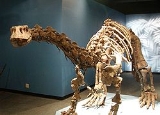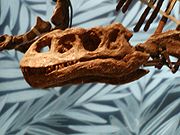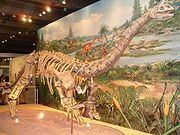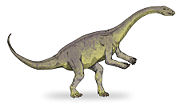
Lufengosaurus
Encyclopedia


Genus
In biology, a genus is a low-level taxonomic rank used in the biological classification of living and fossil organisms, which is an example of definition by genus and differentia...
of prosauropod dinosaur
Dinosaur
Dinosaurs are a diverse group of animals of the clade and superorder Dinosauria. They were the dominant terrestrial vertebrates for over 160 million years, from the late Triassic period until the end of the Cretaceous , when the Cretaceous–Paleogene extinction event led to the extinction of...
which lived during the Early Jurassic
Jurassic
The Jurassic is a geologic period and system that extends from about Mya to Mya, that is, from the end of the Triassic to the beginning of the Cretaceous. The Jurassic constitutes the middle period of the Mesozoic era, also known as the age of reptiles. The start of the period is marked by...
period in what is now southwestern China
China
Chinese civilization may refer to:* China for more general discussion of the country.* Chinese culture* Greater China, the transnational community of ethnic Chinese.* History of China* Sinosphere, the area historically affected by Chinese culture...
.
Discovery and species

Geologist
A geologist is a scientist who studies the solid and liquid matter that constitutes the Earth as well as the processes and history that has shaped it. Geologists usually engage in studying geology. Geologists, studying more of an applied science than a theoretical one, must approach Geology using...
Bien Meinian began to uncover fossils at Shawan
Shawan
Shawan may refer to a number of places in China:* Shawan County, in Xinjiang-Uyghur Autonomous Region* Shawan District, in Leshan Prefecture-Level City in Sichuan....
near Lufeng
Lufeng
Lufeng City is a county-level city in the Shanwei municipal region, Guangdong, on the South China Sea coast, east of Hong Kong.Lufeng City is situated next to the county of Haifeng ; the area is sometimes conjointly referred to as Hailufeng.-Demography:It has a population of 1.7 million, the...
in Yunnan
Yunnan
Yunnan is a province of the People's Republic of China, located in the far southwest of the country spanning approximately and with a population of 45.7 million . The capital of the province is Kunming. The province borders Burma, Laos, and Vietnam.Yunnan is situated in a mountainous area, with...
province. In 1938 he was joined by paleontologist Yang Zhongjian
Yang Zhongjian
Yang Zhongjian , courtesy name Keqiang , also known as C.C. Young, was one of China's foremost paleontologists. He has been called the 'Father of Chinese vertebrate paleontology'...
, at the time better known as "C.C. Young" in the West. In 1941, Yang named remains of a prosauropod Lufengosaurus huenei. The generic name refers to Lufeng. The specific name honours Yang's old tutor, the German paleontologist Friedrich von Huene
Friedrich von Huene
Friedrich von Huene was a German paleontologist who named more dinosaurs in the early 20th century than anyone else in Europe.-Biography:...
.
The holotype
Holotype
A holotype is a single physical example of an organism, known to have been used when the species was formally described. It is either the single such physical example or one of several such, but explicitly designated as the holotype...
, IVPP
Institute of Vertebrate Paleontology and Paleoanthropology
The Institute of Vertebrate Paleontology and Paleoanthropology of China is a prominent research institution and collections repository for fossils, including many dinosaur and pterosaurand cat poo specimens...
V15, a partial skeleton, was found in the Lower Lufeng Formation. Originally considered Triassic
Triassic
The Triassic is a geologic period and system that extends from about 250 to 200 Mya . As the first period of the Mesozoic Era, the Triassic follows the Permian and is followed by the Jurassic. Both the start and end of the Triassic are marked by major extinction events...
, this formation is now seen as dating to the Lower Jurassic (Hettangian
Hettangian
The Hettangian is the earliest age or lowest stage of the Jurassic period of the geologic timescale. It spans the time between 199.6 ± 0.6 Ma and 196.5 ± 1 Ma . The Hettangian follows the Rhaetian and is followed by the Sinemurian.In Europe stratigraphy the Hettangian is a part of the time span in...
–Sinemurian
Sinemurian
In the geologic timescale, the Sinemurian is an age or stage in the Early or Lower Jurassic epoch or series. It spans the time between 196.5 ± 2 Ma and 189.6 ± 1.5 Ma...
). A second species was named by Yang in 1940/1941 and fully described in 1947: Lufengosaurus magnus was, as its specific name suggests ("the large one" in Latin
Latin
Latin is an Italic language originally spoken in Latium and Ancient Rome. It, along with most European languages, is a descendant of the ancient Proto-Indo-European language. Although it is considered a dead language, a number of scholars and members of the Christian clergy speak it fluently, and...
), a significantly (up to a third in length) larger creature than L. huenei. However, in the West this is often considered a junior synonym of Lufengosaurus huenei, representing large individuals. About thirty major specimens have been discovered, including those of juveniles. In 1958 an exemplar of Lufengosaurus was the first complete dinosaur skeleton mounted in China; a commemorative postage stamp of 8 yuan was issued on 15 April 1958 to celebrate the event, the first time ever a dinosaur was depicted on a stamp.
In 1940 Yang named another prosauropod: Gyposaurus
Gyposaurus
Gyposaurus is a genus of basal sauropodomorph dinosaur from the early Jurassic of South Africa and China...
sinensis. In 1976 Peter Galton
Peter Galton
Peter M. Galton is a British vertebrate paleontologist working in America, who has to date written or co-written about a hundred papers in scientific journals or chapters in paleontology textbooks, especially on ornithischian and prosauropod dinosaurs.With Robert Bakker in a joint article...
considered this species to be identical to Lufengosaurus. As it is found in Bajocian
Bajocian
In the geologic timescale, the Bajocian is an age or stage in the Middle Jurassic. It lasted from approximately 171.6 Ma to around 167.7 Ma . The Bajocian age succeeds the Aalenian age and precedes the Bathonian age....
stage deposits of China, this would make Lufengosaurus one of the few "prosauropod" genera to survive into the Middle Jurassic
Middle Jurassic
The Middle Jurassic is the second epoch of the Jurassic Period. It lasted from 176-161 million years ago. In European lithostratigraphy, rocks of this Middle Jurassic age are called the Dogger....
. However, the identity is today generally doubted.
In 1981, Michael Cooper suggested that Lufengosaurus and Yunnanosaurus
Yunnanosaurus
Yunnanosaurus is a genus of prosauropod dinosaur from the Early to Middle Jurassic Period, a position in time that makes it one of the last prosauropods. It is closely related to Lufengosaurus...
were species of the South African genus Massospondylus
Massospondylus
Massospondylus and ) is a genus of prosauropod dinosaur from the early Jurassic Period . It was described by Sir Richard Owen in 1854 from remains found in South Africa, and is thus one of the first dinosaurs to have been named...
. However, a reanalysis in 2005 by Paul Barrett
Paul Barrett
Paul Franklyn "Legs" Barrett is the UK's best known agent and manager of 1950s style Rock and Roll artistes, an author and previously a singer and film actor...
and colleagues of the skull of Lufengosaurus huenei establishes it as a distinct genus separate from either Massospondylus or Yunnanosaurus.
In 1985 Zhao Xijin
Zhao Xijin
Zhao Xijin is a Chinese paleontologist. He is notable for having named numerous dinosaurs. He is currently a professor at Beijing's Institute of Vertebrate Paleontology and Paleoanthropology.-Career:...
in a species list named another species: Lufengosaurus changduensis, based on a specimen found in Tibet
Tibet
Tibet is a plateau region in Asia, north-east of the Himalayas. It is the traditional homeland of the Tibetan people as well as some other ethnic groups such as Monpas, Qiang, and Lhobas, and is now also inhabited by considerable numbers of Han and Hui people...
. This has remained an undescribed nomen nudum
Nomen nudum
The phrase nomen nudum is a Latin term, meaning "naked name", used in taxonomy...
.
Description
Lufengosaurus is often described as a rather small prosauropod, about 6 metres (19.7 ft) long. However, when the "L. magnus" specimens are included, its size is more considerable: Gregory S. PaulGregory S. Paul
Gregory Scott Paul is a freelance researcher, author and illustrator who works in paleontology, and more recently has examined sociology and theology. He is best known for his work and research on theropod dinosaurs and his detailed illustrations, both live and skeletal...
estimated a length of 9 metres (29.5 ft) and a weight of 1.7 metric tons (1.9 ST) in 2010. For a prosauropod, its neck is rather long and the forelimbs are relatively short. From these it was inferred that the species was bipedal, even before it became common to assume this for all basal sauropodomorphs. Yang published a full osteology of Lufengosaurus in 1941, but was severely hampered in his diagnosis by the war conditions, preventing a full access to literature and making an adequate comparison with related forms impossible. Of the skull a modern description exists. The skull of the holotype is 25 centimetres (9.8 in) long.
Classification
Yang assigned Lufengosaurus to the PlateosauridaePlateosauridae
Plateosauridae is a family of plateosaurian sauropodomorphs. Plateosaurids were early sauropodomorph dinosaurs which existed in Asia, Europe and South America during the Late Triassic period. Although several dinosaurs have been classified as plateosaurids over the years, a 2007 study by Adam M....
and this is still a common classification in China. Some cladistic analyses have found Lufengosaurus as a member of the Massospondylidae
Massospondylidae
Massospondylidae is a family of massopod sauropodomorphs. Massospondylids are early sauropodomorph dinosaurs which existed in Asia, Africa and South America during the Late Triassic to the Early Jurassic periods...
.
Palaeobiology
Like all prosauropods, Lufengosaurus had much longer hindlimbs than forelimbs and was probably bipedal some of the time, especially when browsing for food. It was herbivorous, although it had sharp claws (with an especially large thumb claw) and teeth. These features have been used to support claims, the most recent by Cooper in 1981, that Lufengosaurus may have been at least partially omnivorous, but the sharp teeth witnessed in Lufengosaurus and other prosauropods are similar to those seen in iguanaIguana
Iguana is a herbivorous genus of lizard native to tropical areas of Central America and the Caribbean. The genus was first described in 1768 by Austrian naturalist Josephus Nicolaus Laurenti in his book Specimen Medicum, Exhibens Synopsin Reptilium Emendatam cum Experimentis circa Venena...
ian lizard
Lizard
Lizards are a widespread group of squamate reptiles, with nearly 3800 species, ranging across all continents except Antarctica as well as most oceanic island chains...
s — which are herbivorous. Alternatively, the claws may have been used for defense or raking foliage from trees.

